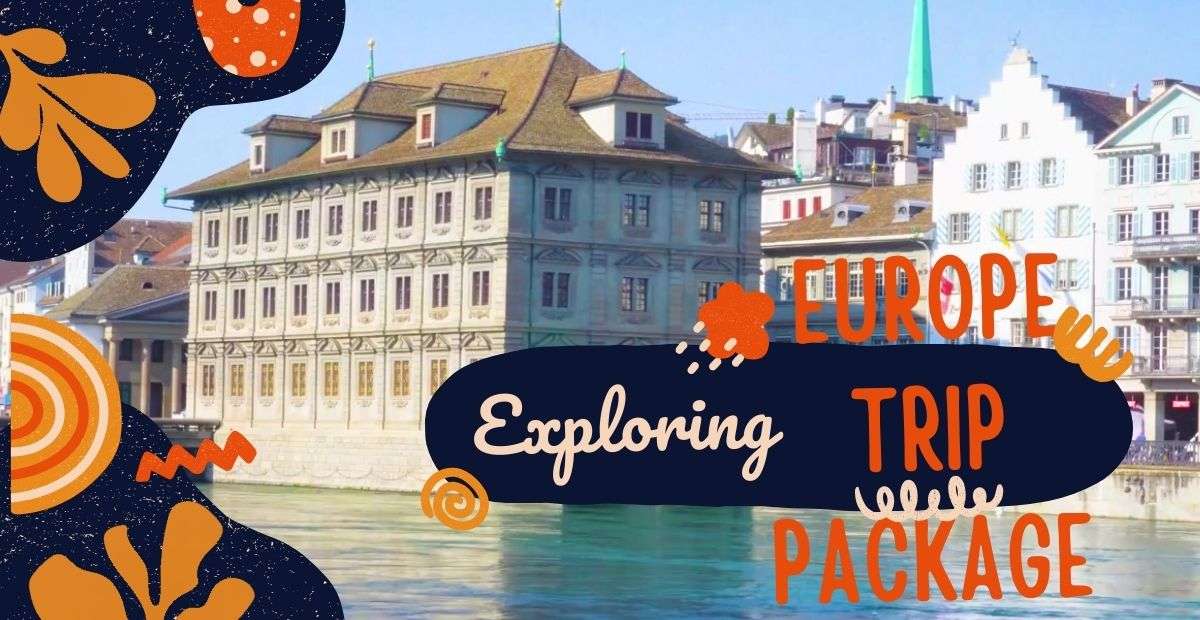Contents
- 1 Europe Trip Package
- 1.1 Choosing the Right Europe Trip Package
- 1.2 Popular Destinations in Europe Trip Packages
- 1.3 Customizing Your Europe Trip Package
- 1.4 Benefits of Booking a Europe Trip Package
- 1.5 Tips for a Successful Europe Trip
- 1.6 Making the Most of Your Europe Trip Package
- 1.7 Frequently Asked Questions (FAQs)
- 1.8 Is 7 days enough for Europe trip?
- 1.9 How much cash to take to Europe?
- 1.10
- 1.11 Which is best time to visit Europe?
- 1.12 Conclusion
Europe Trip Package
Introduction
Planning a trip to Europe can be overwhelming, but using a Europe trip package can simplify the process. These packages offer a variety of options that cater to different preferences and budgets. This guide will help you understand how to use a Europe trip package to create the vacation of your dreams.

Table of Contents
- Introduction
- Choosing the Right Europe Trip Package
- Understanding Your Preferences
- Budget Considerations
- Popular Destinations in Europe Trip Packages
- France
- Italy
- Germany
- Spain
- Customizing Your Europe Trip Package
- Adding Unique Experiences
- Choosing the Best Accommodations
- Benefits of Booking a Europe Trip Package
- Cost Savings
- Convenience
- Tips for a Successful Europe Trip
- Packing Essentials
- Travel Insurance
- Making the Most of Your Europe Trip Package
- Local Cuisine
- Cultural Etiquette
- Transportation Tips
- Frequently Asked Questions (FAQs)
- How much a Europe trip will cost?
- Is 7 days enough for Europe trip?
- How much cash to take to Europe?
- Which is best time to visit Europe?
- Conclusion
Choosing the Right Europe Trip Package
Understanding Your Preferences
When selecting a Europe trip package, consider your interests. Do you prefer historical sites, scenic landscapes, or cultural experiences? Knowing your preferences will help narrow down your options and ensure a satisfying trip.
Budget Considerations
Budget is a crucial factor when choosing a Europe trip package. Packages vary significantly in price, so determine your budget beforehand. Look for deals and discounts that can make your trip more affordable without compromising on quality.
Popular Destinations in Europe Trip Packages
France
France is a top destination in many Europe trip packages. From the Eiffel Tower in Paris to the vineyards of Bordeaux, there’s something for everyone. Don’t miss the chance to explore the rich history and exquisite cuisine of this beautiful country.
Italy
Italy offers a mix of history, art, and stunning landscapes. Rome’s ancient ruins, Florence’s art scene, and Venice’s canals are just a few highlights. A Europe trip package to Italy can provide an immersive cultural experience.
Germany
Germany is known for its historical landmarks, vibrant cities, and picturesque countryside. Berlin’s history, Munich’s Oktoberfest, and the scenic beauty of the Black Forest are must-see attractions in a Europe trip package.
Spain
Spain’s diverse regions offer a unique blend of cultures, languages, and traditions. From the beaches of Costa Brava to the architecture of Barcelona and the festivals of Seville, a Europe trip package to Spain promises a memorable adventure.
Customizing Your Europe Trip Package
Adding Unique Experiences
Personalize your Europe trip package by adding unique experiences. Whether it’s a cooking class in Italy, a wine tour in France, or a river cruise in Germany, these activities can make your trip unforgettable.
Choosing the Best Accommodations
Selecting the right accommodations is crucial for a comfortable trip. Europe trip packages often include a range of options, from luxury hotels to budget-friendly hostels. Choose accommodations that suit your preferences and budget.
Benefits of Booking a Europe Trip Package
Cost Savings
One of the main advantages of booking a Europe trip package is cost savings. Packages often include flights, accommodations, and activities at a discounted rate compared to booking separately. This can make a significant difference in your overall travel expenses.
Convenience
A Europe trip package simplifies the planning process. With accommodations, transportation, and activities arranged for you, all you need to do is enjoy your trip. This convenience allows you to focus on experiencing Europe without the stress of organizing every detail.
Tips for a Successful Europe Trip
Packing Essentials
Packing smart is key to a successful trip. Ensure you have comfortable clothing, travel-sized toiletries, and necessary travel documents. Consider the weather and pack accordingly to stay comfortable throughout your journey.
Travel Insurance
Travel insurance is essential for any trip. It provides coverage for unforeseen circumstances such as medical emergencies, trip cancellations, and lost luggage. Make sure your Europe trip package includes travel insurance or purchase it separately.

Making the Most of Your Europe Trip Package
Local Cuisine
Exploring local cuisine is a highlight of any trip. Try regional specialties and local dishes in each destination. Whether it’s French pastries, Italian pasta, or Spanish tapas, enjoying local food enhances your travel experience.
Cultural Etiquette
Understanding cultural etiquette can enrich your travel experience. Learn basic phrases in the local language, be respectful of customs, and dress appropriately. This shows respect and helps you connect with locals.
Transportation Tips
Navigating transportation in Europe can be straightforward if planned well. Use public transport like trains and buses for cost-effective travel. Many Europe trip packages include transportation passes, making it easier to get around.
Frequently Asked Questions (FAQs)
What is included in a typical Europe trip package?
Most Europe trip packages include flights, accommodations, some meals, and guided tours. Some packages also offer additional experiences like cooking classes or wine tastings.
How far in advance should I book a Europe trip package?
Booking at least six months in advance is recommended for the best deals and availability. Early booking also gives you more time to plan and customize your trip.
Are Europe trip packages suitable for solo travelers?
Yes, many packages are designed for solo travelers and offer group tours, making it easy to meet new people and explore safely.
Can I customize my Europe trip package?
Many travel agencies offer customizable packages. You can add or remove activities, choose your accommodations, and tailor the itinerary to your preferences.
Is travel insurance included in Europe trip packages?
Some packages include travel insurance, while others do not. It’s important to check the details and purchase additional coverage if necessary.
How much a Europe trip will cost?
Planning a Europe trip involves various costs depending on factors like travel style, destinations, and duration. For budget travelers, daily expenses could range from $50 to $100, covering hostels, local meals, and public transportation. Mid-range travelers might spend $100 to $250 per day, including comfortable hotels, dining at mid-range restaurants, and occasional tours. Luxury travelers could budget $250 or more daily for upscale hotels, fine dining, private transport, and exclusive experiences. Additional expenses include flights, visas, travel insurance, and activities like museum visits or outdoor adventures. Flexibility and research help tailor costs to fit individual preferences and travel goals.
Is 7 days enough for Europe trip?
Seven days can be enough for a Europe trip if you plan carefully and focus on a few key destinations. Here’s a guide on how to make the most of a 7-day Europe trip:
Is 7 Days Enough for a Europe Trip?
Planning Your Itinerary
When planning a 7-day trip to Europe, it’s essential to choose your destinations wisely. Opt for cities that are close to each other or well-connected by train or short flights. Here are a few sample itineraries:
First Itinerary: Classic Western Europe
- Day 1-2: Paris, France
- Visit the Eiffel Tower, Louvre Museum, and Notre-Dame Cathedral.
- Enjoy a Seine River cruise and explore Montmartre.
- Day 3-4: Brussels, Belgium
- Discover the Grand Place, Atomium, and Manneken Pis.
- Try Belgian waffles, chocolate, and beer.
- Day 5-7: Amsterdam, Netherlands
- Explore the Anne Frank House, Van Gogh Museum, and Rijksmuseum.
- Take a canal cruise and visit the Jordaan district.
Second Itinerary : Southern Europe Highlights
- Day 1-2: Rome, Italy
- Tour the Colosseum, Vatican City, and Trevi Fountain.
- Wander through the Roman Forum and Piazza Navona.
- Day 3-4: Florence, Italy
- Admire Michelangelo’s David at the Accademia Gallery.
- Visit the Uffizi Gallery and Florence Cathedral.
- Day 5-7: Barcelona, Spain
- Discover Sagrada Família, Park Güell, and La Rambla.
- Relax on the beach and explore the Gothic Quarter.
Third Itinerary : Central Europe Charm
- Day 1-2: Prague, Czech Republic
- Explore Prague Castle, Charles Bridge, and Old Town Square.
- Visit the Astronomical Clock and St. Vitus Cathedral.
- Day 3-4: Vienna, Austria
- Tour Schönbrunn Palace, Hofburg Palace, and St. Stephen’s Cathedral.
- Enjoy a concert in one of Vienna’s historic music venues.
- Day 5-7: Budapest, Hungary
- Relax in the thermal baths and visit Buda Castle.
- Stroll along the Danube River and see the Hungarian Parliament Building.
Tips for a Successful 7-Day Europe Trip
- Prioritize Your Must-See Attractions
- Focus on a few major sights in each city to avoid feeling rushed.
- Book Accommodation in Central Locations
- Staying in the city center will save time on transportation.
- Use Efficient Transportation
- Use high-speed trains and short flights to maximize your time.
- Travel Light
- Pack minimally to make moving between cities easier.
- Reserve Tickets in Advance
- Book tickets for popular attractions to skip the lines.
- Consider Guided Tours
- Join half-day or full-day tours to cover more ground efficiently.
- Plan for Downtime
- Schedule some relaxation time to avoid burnout.
A 7-day Europe trip can be both exciting and fulfilling if planned well. By focusing on a few key destinations and prioritizing your must-see attractions, you can enjoy a rich and varied experience. Remember to plan ahead, travel efficiently, and leave some room for spontaneity. With the right approach, a week in Europe can provide unforgettable memories.
How much cash to take to Europe?
When planning a trip to Europe, the amount of cash to bring depends on several factors including your itinerary, spending habits, and access to ATMs or credit cards. Here’s a comprehensive guide to help you decide how much cash to take:
Factors to Consider
- Duration of Stay
- A longer trip will require more cash, but you can also withdraw money as needed.
- Countries Visiting
- Some countries are more cash-oriented than others. Research your specific destinations.
- Daily Expenses
- Estimate daily costs for food, transportation, and activities.
- Access to ATMs
- ATMs are widely available in Europe, but fees may apply.
- Credit Card Usage
- Credit cards are accepted in most places, but some smaller establishments may prefer cash.
Average Daily Budget
Here’s a rough estimate of daily expenses in Europe:
- Budget Traveler: €40-€60 per day
- Mid-Range Traveler: €70-€120 per day
- Luxury Traveler: €150+ per day
Sample Calculation
For a 7-day trip, here’s a budget breakdown:
- Budget Traveler: €40 x 7 days = €280
- Mid-Range Traveler: €100 x 7 days = €700
- Luxury Traveler: €150 x 7 days = €1050
Tips for Carrying Cash
- Small Amounts for Daily Use
- Carry €50-€100 in cash for daily expenses like meals and public transport.
- Emergency Funds
- Keep an additional €100-€200 for emergencies.
- ATM Withdrawals
- Withdraw cash as needed. Check with your bank for fees and international withdrawal policies.
- Mix of Denominations
- Carry a mix of small and large bills for convenience.
- Secure Storage
- Use a money belt or a secure wallet to avoid theft.
Specific Country Considerations
- Western Europe (e.g., France, Germany, Italy)
- Credit cards are widely accepted, but small establishments may prefer cash.
- Eastern Europe (e.g., Czech Republic, Hungary, Poland)
- Cash is more commonly used, though credit cards are becoming more accepted.
- Nordic Countries (e.g., Sweden, Denmark, Norway)
- Credit cards are widely accepted, and cash usage is minimal.
Additional Tips
- Notify Your Bank
- Inform your bank of your travel plans to avoid card blocks.
- Exchange Rates
- Monitor exchange rates and exchange some money before you go if the rate is favorable.
- Use a Travel Card
- Consider using a travel card that offers low or no foreign transaction fees.
- Backup Plan
- Have a backup card or a prepaid travel card for emergencies.
For a 7-day trip to Europe, carrying around €300-€500 in cash should suffice for most travelers, with the rest covered by credit or debit cards. Adjust the amount based on your specific travel style and the countries you are visiting. Remember to keep your cash and cards secure and spread out to avoid losing everything at once.
Which is best time to visit Europe?
The best time to visit Europe largely depends on what you want to do and see. Europe has something to offer year-round, but different seasons bring different advantages. Here’s a breakdown of the best times to visit based on various factors:
Spring (March to May)
Pros:
- Mild weather, especially in Southern Europe.
- Beautiful blooming flowers and lush greenery.
- Fewer tourists compared to summer.
- Lower accommodation and flight prices.
Cons:
- Weather can be unpredictable with occasional rain.
- Some attractions might have limited hours or still be closed from winter.
Ideal For:
- Visiting cities and cultural landmarks.
- Enjoying outdoor activities and gardens.
- Avoiding large crowds.
Summer (June to August)
Pros:
- Warm weather, perfect for beach destinations.
- Long daylight hours.
- Many festivals and outdoor events.
- All tourist attractions are open.
Cons:
- Peak tourist season with large crowds.
- Higher prices for flights and accommodations.
- Hot weather in Southern Europe can be uncomfortable.
Ideal For:
- Beach holidays and coastal regions.
- Festivals and outdoor events.
- Family vacations.
Autumn (September to November)
Pros:
- Mild weather and beautiful fall foliage.
- Fewer tourists compared to summer.
- Harvest season offers unique food and wine experiences.
- Lower accommodation and flight prices.
Cons:
- Weather can be unpredictable, especially in Northern Europe.
- Shorter daylight hours as autumn progresses.
Ideal For:
- Visiting vineyards and experiencing wine festivals.
- Exploring cities and cultural landmarks.
- Enjoying outdoor activities with pleasant weather.
Winter (December to February)
Pros:
- Winter sports in the Alps and other mountainous regions.
- Beautiful Christmas markets and holiday decorations.
- Fewer tourists in major cities.
- Lower prices for flights and accommodations (excluding holiday season).
Cons:
- Cold weather, especially in Northern and Eastern Europe.
- Shorter daylight hours.
- Some attractions and rural areas might be closed or have limited access.
Ideal For:
- Skiing and snowboarding.
- Experiencing Christmas markets and holiday festivities.
- Visiting major cities without large crowds.
Specific Recommendations
- Best for Beach Holidays: Southern Europe (Spain, Italy, Greece) in late spring or early autumn for pleasant weather and fewer crowds.
- Best for City Breaks: Major cities like Paris, Rome, London, and Barcelona are great in spring and autumn for mild weather and fewer tourists.
- Best for Winter Sports: The Alps (France, Switzerland, Austria) and other mountainous regions in winter for excellent skiing and snowboarding conditions.
- Best for Cultural Experiences: Central and Eastern Europe (Prague, Vienna, Budapest) in spring and autumn to enjoy cultural landmarks without the summer crowds.
- Best for Festivals: Summer is ideal for festivals across Europe, from music festivals in the UK and Germany to cultural festivals in Spain and Italy.
Ultimately, the best time to visit Europe depends on your preferences and what you want to experience. Spring and autumn are generally considered the best times for pleasant weather, fewer crowds, and reasonable prices. Summer is ideal for beach holidays and festivals, while winter offers unique experiences like Christmas markets and winter sports.
Conclusion
Using a Europe trip package can transform your travel experience, making it more enjoyable and hassle-free. By choosing the right package, customizing it to your preferences, and following essential tips, you can create a memorable European adventure. Start planning your dream trip today and explore the best of what Europe has to offer.


Unlim Casino предоставляет непревзойденные возможности для всех игроков, желающих испытывать азартных
игр. В нашем казино вы найдете обширную коллекцию слотов, рулеток, а также интересные акции и турниры,
которые помогут вам существенно повысить шансы на
выигрыш.
Мы стремимся предоставить вам максимальное
удобство опыт, будь то на вашем смартфоне или ПК.
Мы постоянно обновляем коллекцию игр и проводим турниры, чтобы
каждый игрок мог найти что-то для себя.
Что вас ждет, если вы присоединитесь к нам?
Простой процесс регистрации — всего несколько
шагов, и вы готовы начать играть.
Бонусы для новых игроков — вы получаете бонусы на
первый депозит, чтобы начать с максимальными шансами.
Ежедневные акции и турниры — для всех, кто хочет повысить шанс на крупный выигрыш и дополнительные
призы.
Круглосуточная поддержка всегда готова помочь с любыми вопросами, связанными с игрой.
Игры, доступных на любой платформе — будь то ПК или мобильное устройство.
Присоединяйтесь прямо сейчас!
Unlim Casino ждет вас, где вас ждут увлекательные моменты и шанс выиграть огромные призы.
Готовы к новым победам? https://unlimcasino-jackpotarena.site/
I think you have observed some very interesting points, regards for the post.